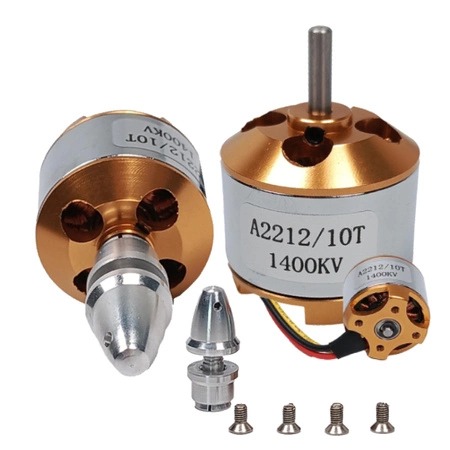Add products by adding codes
Brushless motor advantages and disadvantages - what you should know.

Brushless motor advantages and disadvantages - what you should know.
BLDC brushless motors is a modern solution that is gaining popularity in power tools. The absence of a mechanical commutator and brushes makes them more efficient and effective. Compared to traditional brush motors, they offer many advantages.
High efficiency, up to 90%, is one of the key features of brushless motors. That's 10% more than brush motors. As a result, energy savings are significant. BLDC motors are smaller, lighter and quieter for greater comfort.
Key information
- Brushless motors have efficiencies of up to 90%
- Characterized by lower energy consumption
- They are quieter and lighter than brush motors
- Offer more power and torque
- They have a longer life span and break down less often
- Despite the higher price, they are more profitable in the long term
Introduction to brushless motors
Brushless motors are a new development in electric drives. Their design and operation differs from traditional brush motors. They offer many benefits in a variety of applications.
Definition of a brushless motor
A brushless motor is a type of electric motor without a mechanical commutator with brushes. Instead, it uses an electrically controlled commutator. The coils are stationary, and the magnets on the rotor. This eliminates the need for brushes, which improves engine performance and durability.
History of brushless motor development
The first brushless motors were developed as an alternative to traditional brush motors. Development of semiconductor technology in the 1960s. In the 1970s, it made it possible to effectively control. This has contributed to the popularity of brushless motors.
Basic differences between brush and brushless motors
The main difference is the lack of brushes and mechanical commutator in brushless motors. This leads to better efficiency and sustainability. Brushless generators and servo drives have higher energy efficiency and longer service life. DC brushless motor can run about 6 times longer than brush motor.
- Brushless motors are more reliable and operate maintenance-free
- The speed of brushless motors depends on the frequency of the supplied current, not the voltage
- Cooling is done by conduction or without air flow
The price of brushless DC motors is higher than traditional ones. Controller requirements are high. However, their benefits often outweigh the initial costs.
Construction of the brushless motor
BLDC brushless motors have a unique structure. Distinguish from traditional brush motors. It consists of an external rotor with neodymium magnets and a steel body with coils.
ESC controllers are key in these engines. They replace the mechanical commutator. Electronic RPM control system uses Hall sensors to track the rotor.
- Longer life and less frequent maintenance
- Quieter operation
- Higher energy efficiency
- Improved speed and torque control
BLDC brushless motors are popular in industry and robotics. They are also used in electric vehicles and electronic tools. Thanks to their design, they work effectively at different speeds.
| Feature | BLDC brushless motors | Brush motors |
|---|---|---|
| Energy efficiency | High | Lower |
| Lifespan | Long | Shorter |
| Maintenance | Rare | Frequent |
| Noise level | Low | Higher |
| Production cost | Higher | Lower |
Although more expensive, BLDC brushless motors offer many advantages. Their advanced design and ESC systems ensure high performance. They are reliable in a variety of applications.
Operating principle of the brushless motor
Brushless motor is a cutting-edge solution that is changing many industries. Works thanks to a unique coil power system. This translates into many advantages.
The role of neodymium magnets
Neodymium magnets are key for brushless motor. They create a strong magnetic field that drives the rotor. Thanks to them, the engine achieves high energy efficiency of up to 90%.
Functioning of coils in a star system
The coils in the motor are arranged in a star pattern. This allows for sequential feeding, leading to smooth rotor rotation. This makes the motors ideal for applications requiring precision control.
Electronic speed control system
ESC controllers is the heart of the brushless motor control system. Enable precise speed and torque control. This makes the motors popular in power tools where it is important to control operating parameters.
The brushless motor has many advantages, such as quieter operation and greater durability. But it also has drawbacks, like higher cost and the need for advanced control systems.
Brushless motor advantages and disadvantages
Brushless motor has many advantages and limitations. It's important to understand these aspects. This will allow you to better assess its value.
Let's move on to the advantages. Brushless motors are very energy efficient. As a result, electrical appliances work longer. The absence of brushes reduces the risk of sparking, which increases safety and durability.
These engines are quieter and less vibrating. This improves the user experience. In addition, they have a better power-to-weight ratio. This increases the efficiency of power tools.
Brushless motors are becoming increasingly popular in the body and paint industry. It is due to their advantages.
- Increased energy efficiency
- Longer life
- Lower failure rate
- Lower noise and vibration levels
The disadvantages of brushless motors are mainly the higher cost and complicated control system. There may also be power problems in some systems.
While there are limitations, the advantages of brushless motors often outweigh. Brushless generators, being a variation of them, are gaining popularity in various industries. It is due to their reliability and efficiency.
Comparison of brushless and brush motors
BLDC brushless motors and brushless servo drives are becoming increasingly popular. Many industries choose them over traditional brush motors. What are their main differences?
Energy efficiency
BLDC brushless motors use less energy. Can save up to 20-30% energy compared to brush motors. This makes the devices run longer on a single charge.
Durability and reliability
Brushless motors are more durable and reliable. They don't have brushes that wear out. This reduces the risk of failure. Their better cooling allows them to work longer.
Production and operating costs
Brushless motors are more expensive to produce. But their higher price may pay off in the long run. Lower energy consumption and longer life compensate for higher costs.
| Feature | Brushless motors | Brush motors |
|---|---|---|
| Energy efficiency | 20-30% higher | Lower |
| Durability | Very long | Limited brush wear |
| Reliability | High | Average |
| Production costs | Higher | Lower |
| Operating costs | Lower | Higher |
Brushless motor applications
Brushless motors are popular in many fields. They have high energy efficiency, operate quietly and are durable. Brushless generators i eSC controllers are key in these solutions.
In power tools like screwdrivers and drills, brushless motors give you more power. They make tools run longer on a single charge and last longer. They eliminate sparking, which increases safety.
- Efficiency of brushless motors reaches up to 95%
- The industrial machinery segment accounted for about 40% of the global brushless motor market in 2018.
- Global brushless DC motor market expected to grow at an average annual rate of 9.3%
In homes, brushless motors are in washing machines, dryers or air conditioners. They help save energy and are quiet. In industry and robotics, are valued for speed and torque control.
Brushless motors in power tools
Brushless motors are changing the world of power tools. They give users many benefits. Improve productivity and efficiency at work.
Impact on tool performance
It's worth learning about the advantages and disadvantages of brushless motors. They make tools work better, by up to 30%. They also have higher speeds, up to 25,000 rpm.
These engines generate less heat and noise. This improves the working experience. They also do not interfere with the radio or phone, which is very useful.
Examples of popular power tools with brushless motors
Many tools have brushless motors. They are:
- Drillers
- Screwdrivers
- Hammer Drillers
- Grinders
These tools are lighter and quieter. They also give longer run time on a single charge. Although they are more expensive, the cost is worth it due to their durability and lower operating costs.
Maintenance and service life of brushless motors
BLDC brushless motors have changed the way we take care of appliances. They don't need frequent maintenance because they don't have brushes. This means fewer visits to the site.
They require only occasional lubrication of bearings. This makes them great for working in harsh environments.
These motors live long lives thanks to the lack of brushes. As a result, they work less and costs are lower.
Brushless motors are quiet. This is important when it comes to low noise levels.
Brushless generators are also long-lived and cheap to maintain. They are great for a variety of industrial applications.
| Feature | Brush motors | BLDC brushless motors |
|---|---|---|
| Maintenance | Regular replacement of brushes | Minimal (bearing lubrication) |
| Lifespan | Shorter | Much longer |
| Noise level | Higher | Lower |
| Maintenance costs | Higher | Lower |
Impact of brushless motors on operating efficiency
Brushless motors significantly improve operating efficiency. Their use translates into better performance and tool comfort.
Increased power and torque
Professionals often talk about the advantages of brushless motors. They have a higher capacity. Offer 20% to 30% more power than brush motors.
More power means more torque. This translates into better tool performance.
Vibration and noise reduction
Brushless motors reduce vibration and noise levels. Brushless grinders using, feel 20% less noise. So the tools are easier to use.
Longer operating time on a single charge
Tools with brushless motors run longer on a single charge. This is important for cordless tools. In addition, ESC systems optimize energy consumption, resulting in even longer operating time.
| Parameter | Brushless motor | Brush motor |
|---|---|---|
| Performance | +20-30% | Standard |
| Noise reduction | Up to 20% | No |
| Durability | 10x larger | Standard |
| Operating costs | -10% | Standard |
To sum up, brushless motors increase the efficiency of work. Offer more power, quieter operation and longer operating time. This makes them increasingly popular with professionals and those who use tools frequently.
Development of brushless motor technology
BLDC brushless motors are becoming increasingly popular in various industries. Their development is focused on increasing efficiency and sustainability. Thanks to electronic commutation, brushless servo drives offer precise speed and torque control.
Technological advances mean that BLDC brushless motors have:
- Lower noise levels
- Less electromagnetic interference
- Higher energy efficiency
- Longer life
Manufacturers like Chaoya have specialized in brushless motors for more than a decade. They are working on improving them. Key areas include:
- Miniaturization
- Torque improvement
- Increasing energy efficiency
- Integration with advanced control systems
Brushless servo drives are used in power tools, fans and lawnmowers. They can work tens of thousands of hours, depending on the quality and working conditions.
| Feature | Brush motors | BLDC brushless motors |
|---|---|---|
| Noise | Higher | Lower |
| Maintenance | Frequent | Minimum |
| Energy efficiency | Low | High |
| Lifespan | Shorter | Longer |
Development of BLDC brushless motor technology increases its application in industry and robotics. Offer better performance and reliability than traditional solutions.
Brushless motors in industry and robotics
Brushless motors are becoming increasingly popular in industry and robotics. They have many advantages, such as higher efficiency and reliability. They are better than brush motors because they have about 10% higher efficiency and less risk of failure.
In robotics, brushless motors are very important. They serve in drones, RC vehicles and industrial robots. Their precision and reliability make them great for tasks that require accuracy, such as assembly or painting.
In industry, brushless generators and ESC controllers are key. Enable precise management of speed and torque. This is important in many industrial applications.
| Application | Number of responses | Number of displays |
|---|---|---|
| PMSM synchronous motors | 245 | 52,524 |
| Induction motors with neodymium magnets | 18 | 6,719 |
| BLDC vs induction motors | 12 | 1,023 |
| Reluctance and inverter-powered motors | 23 | 2,601 |
These figures show that brushless motors in the industry are very interesting. PMSM synchronous motors, in particular, attract a lot of attention and have the most displays.
Ecological aspects of using brushless motors
BLDC brushless motors are becoming increasingly popular. Their ecological properties help reduce the negative impact on the environment. Compared to traditional brush motors, they are better for the planet.
Reduced energy consumption
High energy efficiency is the main advantage of brushless motors. Consume less energy than brush motors. This leads to less electricity consumption and less CO2 emissions.
Longer life vs. reduction in electronic waste
Brushless motors live longer than brush motors. That means fewer replacements and less electronic waste. The lack of brushes also reduces waste.
| Environmental aspect | Brushless motor | Brush motor |
|---|---|---|
| Energy consumption | Low | High |
| Lifespan | Long | Shorter |
| Waste generation | Minimum | Significant |
Many fields use brushless motors, such as in electric vehicles. For example, the BMW CE 04 electric scooter can travel 150 km on a single charge. This shows how these engines reduce emissions in urban transportation.
The future of brushless motors
The development of brushless motors is growing rapidly. The future of these devices looks promising. We expect big improvements in efficiency and smaller size. Brushless servo drives will be increasingly used in electric cars and industrial machines.
Technology can reduce production costs. This will make brushless motors more readily available. The ESC controller, important for these engines, will evolve, becoming better and more efficient.
Here are the main trends that are shaping the future of brushless motors:
- Increase in energy efficiency
- Further miniaturization
- Reducing production costs
- Wider use in electric vehicles
- Development of advanced ESC controllers
Brushless motors could change many industries. Their popularity is growing in electronic tools. Could be important in robotics, medicine and aerospace in the future.
| Feature | Current brushless motors | Future brushless motors |
|---|---|---|
| Energy efficiency | High | Very high |
| Size | Compact | Ultra-compact |
| Production costs | High | Moderate |
| Application in electric vehicles | Limited | Common |
| Advancement of ESC controllers | Advanced | Highly advanced |
Application
Brushless motors are changing the market for power tools and electric vehicles. They have high efficiency, which allows for longer use. In addition, they are more durable and reliable.
In three years, the number of electric vehicles has increased 140-fold, reaching 75,000. Brushless motors have both downsides and upsides. Their higher initial price is offset by performance and long service life.
Brushless technology has great prospects. Many power tool manufacturers offer devices with brushless motors. They are lighter, quieter and generate less heat. In electric vehicles, they eliminate the need for transmissions, making the drive more efficient.
FAQ
What is a brushless motor?
A brushless motor is a type of electric motor. Instead of brushes, it uses an electrically controlled commutator. The coils are stationary, and the magnets on the rotor.
What are the main differences between brush and brushless motors?
Brushless motors have no brushes and no mechanical commutator. This makes them more effective and more durable.
What are the main components of a brushless motor??
It consists of a rotor with neodymium magnets, a steel body with coils and an electronic speed control system.
What is the role of neodymium magnets in a brushless motor?
Neodymium magnets create a strong magnetic field. This is necessary to set the rotor in motion.
What are the main advantages of brushless motors?
They have higher energy efficiency and no sparks. They're more durable, less malfunctioning and lighter. They also feature less noise and vibration.
What are the disadvantages of brushless motors?
They are more expensive than brush motors and more complicated to build.
In which devices and industries are brushless motors used?
They are used in power tools, optical disk drives, hard drives, hybrid cars and segways. They are also used in computer fans, remote-controlled models, industry, robotics and electric vehicles.
How brushless motors affect power tool performance?
Improve the performance of power tools, offering more power and torque. They are lighter, quieter and run longer on a single charge.
What is the maintenance of brushless motors?
Maintenance is minimal because there are no brushes. It is only important to lubricate the bearings sometimes.
What is the environmental impact of brushless motors?
Have a positive impact on the environment. They use less energy, which reduces CO2 emissions. Their longer lifespan means less electronic waste.



